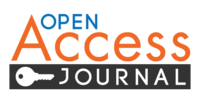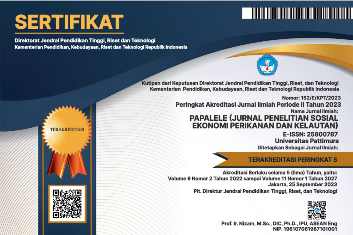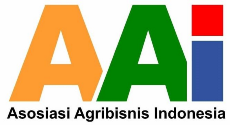PERAN PEMUDA DALAM PEMBANGUNAN SEKTOR PERIKANAN MARIKULTUR DI TELUK AMBON DALAM
Abstract
Building the mariculture fisheries sector in Ambon can be an effort to build the regional economy. Cultivated fisheries other than capture fisheries are an economic driver because Indonesia is one of the world's fish sources, so the development of marine and fisheries aims to meet the needs of the international market. In developing the mariculture fisheries sector, youth participation is very necessary. Youth is very decisive in determining the progress and decline of development, but in reality, the youth now lacks awareness and willingness to be involved in development. Partial Least Square in Structural Equation Modeling with SmartPLS 3.0 software was used in this study to predict the effect of the exogenous latent variable X (factors determining the role of youth) to the endogenous latent variable Y (forms of the role of youth in the development of the mariculture fisheries sector) and describes the theoretical relationship between the two variables. SEM_PLS analysis results show that, resources have a significant effect on because the resources owned by youth are quite adequate. Social capital has a less significant effect because some youth are beginners. Public policies have a less significant effect because generally policies are directed at business managers who have succeeded in production so that young youth are less targeted for policy implementation. Entrepreneurship has a less significant effect because youth are still dominantly involved as members of business and labor groups so that not many have taken on the role of manager of floating net cage businesses.
Downloads
References
BAPPEDA [Badan Perencanaan dan Pembangunan Daerah] Kota Ambon., 2011. Rencana Tata Ruang Wilayah (RTRW) Kota Ambon tahun 2011-2031. Ambon.
BPS [Badan Pusat Statistik Kota Ambon]., 2020. Kota Ambon dalam Angka. http://ambonkota.bps.go.id.
Dault Adhyaksa, 2007. “Peningkatan Peran Pemuda Dalam Pembangunan Kelautan Perikanan Di Kabupaten Sukabumi Jawa Baratâ€. Pascasarjana. IPB. Bogor.
Ghozali, 2014. Struktural Equation Modeling Metode Alternatif dengan Partial Least Square. Semarang: Badan Penerbit Undip.
Nikijuluw V. P. H., 2005. “Politik Ekonomi Perikanan, Bagaimana Dan Kemana Bisnis Perikanan. Jakarta: Ferry Agung Corporation.
PERDA [Peraturan Daerah] Provinsi Maluku Nomor 1 tahun 2018. Tentang Rencana Zonasi Wilayah Pengelolaan Pesisir dan Pulau-pulau Kecil (RZWP3K) Provinsi Maluku.
PERMEN KKP [Peraturan Menteri Kelautan dan Perikanan] Republik Indonesia Nomor 12 tahun 2007. Tentang Perizinan Usaha Pembudidayaan Ikan. Jakarta.
Risakotta T., 2018. Model Pengembangan Industri Kreatif Berbasis Sumberdaya Pesisir Dan Laut di Kota Ambon. [Tesis]. Pascasarjana. MSKP. Unpatti. Ambon.
Sugiyono, 2010. Metode Penelitian Kuantitatif, Kualitatif dan R&B. Bandung: Alfabeta.
Yamin S., Kurniawan H., 2011. Generasi Baru Mengolah Data Penelitian dengan Partial Least Square Path Modeling. Jakarta: Salemba Infotek.
Undang-undang Republik Indonesia Nomor 40 tahun 2009 Tentang Kepemudaan.
Copyright (c) 2020 Ongen Rumaryo Lekirupy, Johanis Hiariey, Yoisye Lopulalan

This work is licensed under a Creative Commons Attribution-NonCommercial 4.0 International License.











